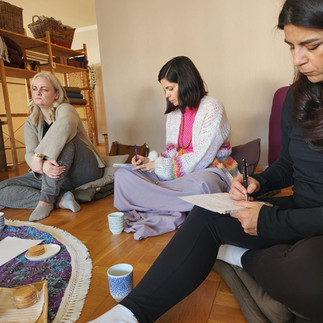Gita Conversations & Zoom Recording
- Natural Joy Yoga

- Mar 17
- 3 min read
Updated: Apr 1
"What is done is done; what is to come has not yet come.
Only what is, the present, is real."
Have you ever felt stuck between what you 'should' do and what your heart truly calls for?

This inner conflict is at the heart of the Bhagavad Gita, one of the most profound spiritual texts in history. In a powerful dialogue between Prince Arjuna and Lord Krishna, the Gita offers timeless wisdom on duty, self-discovery, and the path to true fulfillment.
In many ways, Arjuna’s inner conflict on the battlefield mirrors the struggles we face in modern life. Whether it’s difficult decision-making, career uncertainty, personal relationships, stress, or self-doubt, we often find ourselves standing at a crossroads, unsure of which path to take. Just like Arjuna, we may feel overwhelmed by responsibilities, torn between duty and desire, or paralyzed by fear of the unknown.
The Bhagavad Gita offers timeless wisdom to navigate these challenges, teaching us how to act with clarity, purpose, and inner peace—without being consumed by anxiety or attachment to outcomes. Its lessons remind us that true strength comes not just from external success but from understanding and aligning with our deeper truth.
The Bhagavad Gita and Yoga: Paths to Inner Harmony
The Bhagavad Gita, often called the 'Song of the Divine,' is a spiritual dialogue between Prince Arjuna and Lord Krishna on the battlefield of Kurukshetra. It presents profound teachings on duty (dharma), self-awareness, and the nature of existence. A key teaching of the Gita is the concept of yoga—not just as physical exercise, but as a path to spiritual growth and self-mastery. It describes three primary paths of yoga:
Karma Yoga (Path of Selfless Action) – Acting without attachment to results, dedicating efforts to a higher purpose.
Bhakti Yoga (Path of Devotion) – Surrendering to the divine with love and devotion.
Jnana Yoga (Path of Knowledge) – Seeking wisdom and understanding to transcend illusion and realize the self.
Dharma & Detachment: Acting with Purpose, Without Fear
One of the key teachings we explored in our class with Ina was the concept of Dharma—our unique duty or purpose in life. In the Bhagavad Gita, Krishna reminds Arjuna that acting according to his dharma as a warrior is essential, even when faced with fear and doubt.
This teaching is especially relevant today, as many of us struggle with questions like:
Am I on the right path?
What is my true purpose?
How do I make decisions that align with who I really am?
The Gita teaches that fulfilling our dharma isn’t about external success or validation—it’s about acting with integrity, without attachment to results. By embracing this perspective, we can move through life’s challenges with greater clarity and resilience, knowing that our role—no matter how big or small—has meaning when approached with sincerity and dedication.
The Practice of Detachment (Karma Yoga)
Another essential teaching from the Bhagavad Gita is the concept of Karma Yoga, the path of selfless action. Krishna tells Arjuna:
"Act without attachment to the fruits of your actions." (Bhagavad Gita 2.47)
This reminds us that while we should act with dedication and purpose, we must release our attachment to specific outcomes. True peace comes from doing our best with sincerity while trusting the flow of life.
If this resonates with you, I invite you to reflect on:
✨ What would it feel like to act wholeheartedly, without attachment to results? ✨ Reflect on your own dharma—what calls you forward, even in moments of doubt? ✨ How can you align your actions with your deeper purpose?
📹 Missed the discussion o simply want to revisit our conversation? Here
Let’s keep growing, learning, and supporting each other on this journey. 💛













Comments